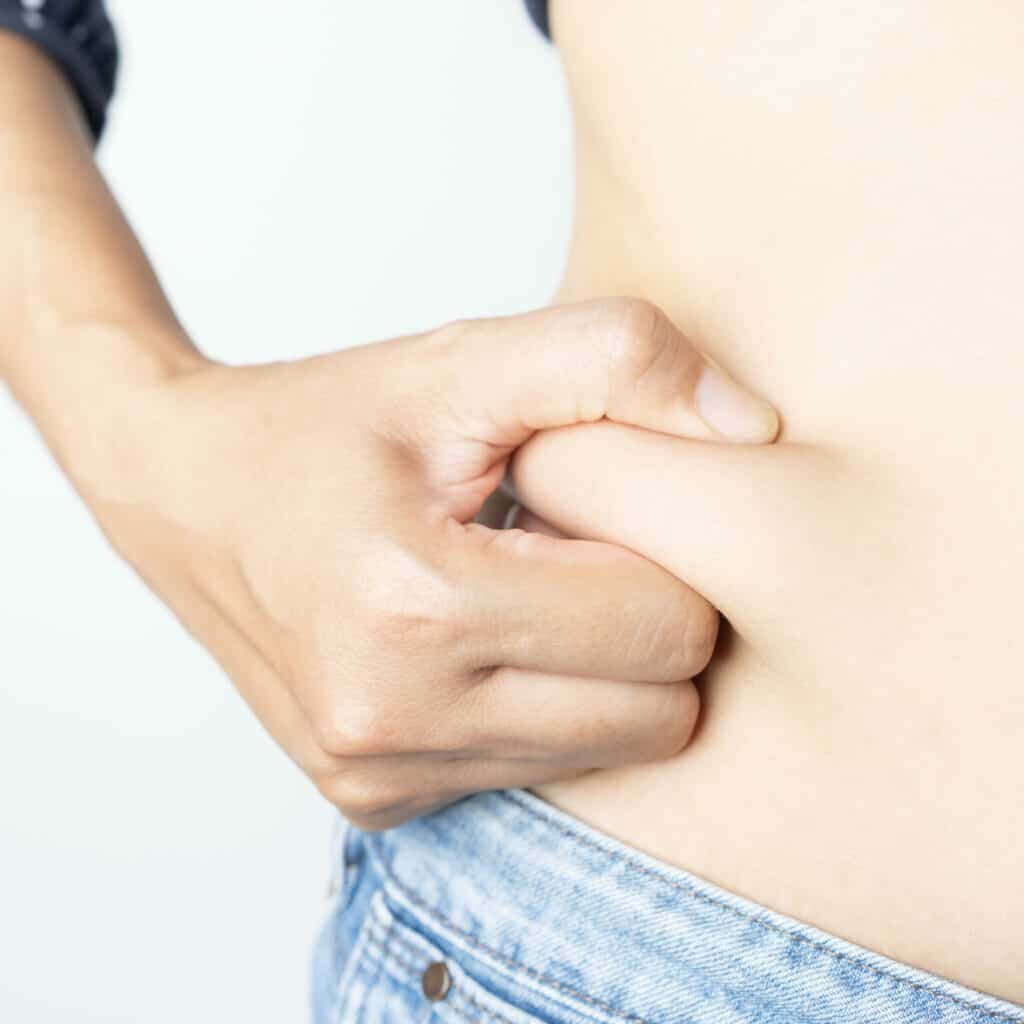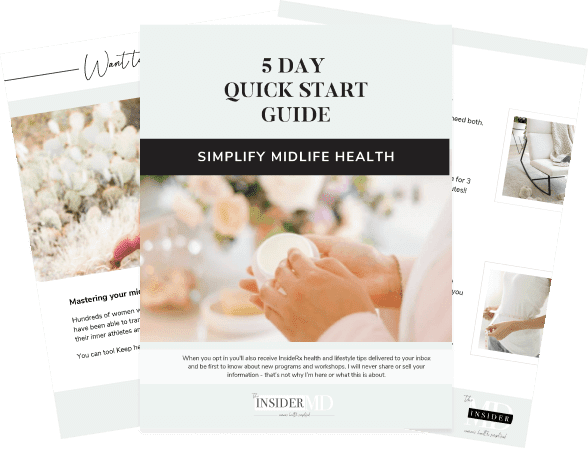
What Causes Menopause Belly Fat and How To Lose It
Many women notice an increase in belly fat as they get older — even if they haven’t gained weight. We recognize this as menopause belly fat, and it’s largely due to decreasing levels of estrogen during the menopause transition, which affects where fat is distributed in the body.
The medical term for this process is ‘central weight distribution’. The tendency to gain or carry weight around the waist may also have a genetic component.
What Causes Menopause Belly Fat?
Before menopause, most estrogen is produced by our ovaries. After menopause, our ovaries no longer produce much estrogen and estrogens mainly come from fat tissue. Proteins, revved up by the estrogen drop, cause fat storage to shift from the hips and thighs to the abdomen.
That’s why, as women progress through menopause, even if the number on the scale isn’t changing that much, fat tends to accumulate around the midriff, creating what is commonly known as, menopause belly fat.
Your weight is determined by three main factors:
- How much you eat
- Your muscle mass and how much you exercise
- Your age
The average woman gains about four-and-a-half pounds during her 40’s, and will continue to put on about a pound and a half each year in her 50s and 60s, according to a study published in the Mayo Clinic Proceedings.
Also, research shows that, starting at age 30, you lose on average about a half pound of muscle each year; and that number increases to almost a pound per year by age 50. As muscle mass decreases, fat increases because loss of muscle mass decreases the rate at which your body burns calories.
How Menopause Belly Fat Affects Your Health
Belly fat includes subcutaneous fat, which is located just beneath your skin, and visceral fat — which surrounds your liver and other internal organs inside your abdomen.

Subcutaneous fat can be a cosmetic concern, but visceral fat is linked with more dangerous health problems. Too much visceral fat is known as abdominal obesity.
Visceral fat sends hormones, fatty acids, and other chemicals that cause inflammation into your body. This leads to Type 2 diabetes, high blood pressure, abnormal cholesterol and breathing problems. Reducing visceral fat lowers the health risks that come along with it.
How Much Belly Fat is Too Much?
Measure your middle. To know if you have too much belly fat, measure your waist.
Stand and place a tape measure around your bare stomach. Relax, exhale and measure your waist, resisting the urge to suck in your stomach.
A waist measurement of more than 35 inches (89 centimeters) indicates an unhealthy concentration of belly fat and a greater risk of health problems.
Measure your waist-to-hip ratio. This measurement compares your waist size to your hip size and can give you a better picture of your health than just your weight or body mass index (BMI) which measures your weight against your height.
That’s because you can be at a healthy weight but have too much fat around your midsection which increases your health risks. In general, your waist should be smaller than your hips, no matter your weight or BMI.
How to Lose Menopause Belly Fat
Visceral fat responds well to the same diet and exercise strategies that help you lower your total body fat.
Eat a Mediterranean style diet.
That means focusing on fruits, vegetables and whole grains, lean sources of protein and low-fat dairy products. Avoid added sugar and saturated fat, which is found in meat and high-fat dairy products, such as cheese and butter. Choose moderate amounts of monounsaturated and polyunsaturated fats — found in fish, nuts and certain vegetable oils — instead. A study of 17,000 postmenopausal women ages 50 to 79, found that those who followed a low-fat diet that included five servings of fruits and veggies and six servings of whole grains were three times more likely to lose weight than those in a control group.
Hydrate.
Drink lots of water and avoid sugary sodas and beverages.
Eat smaller portions.
Even with healthy foods, calories add up. At home, watch your portion sizes. In restaurants, share an entree — or eat half your meal and take the rest home.
Make physical activity a daily routine.
Aim for moderate aerobic activity, such as brisk walking, for at least 150 minutes a week ( 30 minutes 5 times per week).
Gradually increase the intensity.
If you’ve been sedentary, starting an exercise program will help you lose weight as well as relieve menopausal symptoms such as hot flashes, according to a study published last year in the medical journal Menopause. But, eventually, you’ll have to step things up a notch.
The best way to do this is through a short duration of high-intensity interval training (HIIT), where you alternate brief periods of intense physical activity with more relaxed recovery periods. This can be as simple as adjusting your morning walk to throw in some hills. Obese postmenopausal women who did 10 minutes of HIIT five times a week lost twice as much weight as those who did just brisk walking, according to a University of Scranton study published in Menopause.
Add in resistance training.
To lose weight as you get older, you have to lift weights because it reverses the muscle loss that occurs naturally with age. A study of post-menopausal women in their late 50s and 60s found that an hour of strength training twice a week for eight weeks significantly reduced body fat compared to a control group. If you’re resistant to lifting weights, consider yoga which has similar weight-bearing benefits.
Get enough sleep.
Lack of sleep doesn’t just feel terrible, it leads to weight gain over time. Lack of sleep interferes with your hunger hormones: It lowers leptin levels, which help suppress appetite, and increases ghrelin, which stimulates your appetite.
One study showed that, over a 16 year period, women who slept less than five hours a night had a 30 percent higher risk of gaining 30 pounds, compared to those who regularly got seven hours. If you have trouble getting the rest you need, consider a short course of a type of counseling called cognitive behavior therapy (CBT), which uses behavioral techniques to help promote sleep. According to a study published in the medical journal Sleep, both menopausal and postmenopausal women who used CBT showed a significant reduction of insomnia within two to three months.
If hot flashes are disrupting your sleep, hormone replacement therapy, certain antidepressants such as low-dose paroxetine (Brisdelle), venlafaxine (Effexor), or escitalopram (Lexapro), or the drug gabapentin (Neurontin) are all also options to discuss with your doctor.
Menopause Belly Fat: Final Thoughts
- Weight gain is not the same as weight distribution. Many women gain weight as they get older due to natural muscle loss with aging and lifestyle factors. With the hormonal changes of menopause, weight tends to redistribute to the abdomen.
- Abdominal obesity causes inflammation which leads to Type 2 diabetes, high blood pressure, abnormal cholesterol and breathing problems.
- Reducing abdominal fat lowers the health risks that come along with it.
- Aim for a waist measurement of less than 35 inches and/or a waist that is smaller than your hips to optimize your health.
- To lose menopause belly fat, adopt the same diet and exercise strategies that help you lower your total body fat and, be sure to get enough sleep.

MEET DR. ELLEN
My mission is to bring you the most up-to-date, proven medical information, simplified, so you can make confident, educated decisions about your health.
I'M LOOKING FOR...
grab your 5 day
quick start guide



